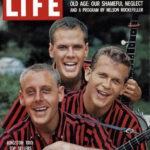“I didn’t know it was a musical,” my partner remarked as we headed to the cinema on a blustery Glasgow evening. We were there to see Wonka, the origin story of the eccentric chocolatier we all know and… somewhat fear for factory safety standards.
Let’s cut to the chase: Wonka is a delightful, feel-good family film, but it falls short as a truly great musical. Timothée Chalamet is undeniably charming and quirky in the lead role, making you believe in his whimsical dreams. The supporting cast is a stellar ensemble, packed with talent capable of headlining their own projects. Special mention to Olivia Colman and Tom Davies, whose villainous Mrs. Scrubbit and her accomplice are perfectly wicked without resorting to caricature.
The film opens with Chalamet perched atop a ship’s mast, gazing optimistically at his future. As he slides down a rope, the movie bursts into its first musical number, ‘a hat full of dreams’, a classic “I want” song with a jaunty rhythm. For a moment, the promise of a full-fledged musical is genuinely exciting. You hope for two hours of this infectious energy. However, by the end of this introductory song, which is meant to immerse us in Wonka’s world, a sense of wanting more musically begins to creep in.
As a musical enthusiast, I understand the potential hesitation around the genre. Studios sometimes seem to downplay the musical aspect in marketing, fearing audience aversion. It’s true, musicals demand a greater suspension of disbelief and ask more from the viewer. But this isn’t inherently negative. What is disappointing is when a film with the potential of Wonka treats its musical elements as an afterthought.
The songs for Wonka are penned by Neil Hannon of Divine Comedy fame. Objectively, they are decent. They are catchy, clever, and lyrically fit the film’s whimsical world. Hannon is a demonstrably skilled artist. Yet, his score feels constrained by a lack of musical ambition within the film itself, and perhaps by some casting choices. There was potential for the music to be more impactful, but the movie didn’t provide the necessary space.
While studios may perceive original musicals as a risky venture, Wonka isn’t entirely new territory. It’s based on a beloved existing property, a universe already familiar to audiences. The film’s secret weapon should have been the evocative ‘pure imagination’ refrain, subtly woven into the score and beautifully reprised as a full song at the film’s conclusion. This iconic melody is undeniably effective.
However, beyond a few pleasant motifs and catchy tunes, the Wonka songs don’t venture deep enough. Crucially, the songs rarely advance the narrative or offer insight into character emotions or motivations. Many numbers simply describe on-screen action, with ‘Scrub Scrub’ being a prime example. The supposedly show-stopping ‘You’ve Never Had Chocolate Like This’ feels disruptive rather than climactic, awkwardly shifting between musical styles as if unsure of its own identity. In one scene, Wonka offers chocolates to tram passengers, declaring, “just pop one in and everything becomes a broadway show.” Upon tasting the “42nd sweet,” they erupt into song and dance, mimicking musical theatre performers. It’s a bold, if slightly jarring, choice to surround Chalamet with seasoned musical theatre talents like Robyn Rose and Millie O’Connell, especially when his own earlier dance sequence on a table felt less assured.
There’s value in assuring the audience of a performer’s capabilities. The Greatest Showman, despite its flaws, showcased exceptional performers front and center. When Hugh Jackman or Keala Settle sang, there was no question of their vocal prowess. With Wonka, however, the musical numbers sometimes feel tailored to accommodate the lead actor’s vocal range, potentially limiting the songs themselves.
That opening musical sequence with Chalamet singing from the mast did elicit some uneasy laughter in the cinema – perhaps unfairly, but understandably. To fully embrace a world where characters spontaneously sing, audiences need confidence in their vocal abilities. In Wonka, this issue extends to supporting roles where otherwise excellent actors seem slightly uncomfortable singing. It doesn’t give these performers, or their roles, the best chance to shine. Even a great actor can falter if they cannot effectively “act through song.”
Casting a non-dancer in a dance-centric film would be unthinkable. Yet, in movie musicals, we often accept actors with limited singing ability simply because of their star power.
“Yes, I loved it, but Pierce Brosnan cannot sing” – this was a common reaction after the first Mamma Mia! film. While Brosnan’s vocal performance might not be technically perfect, his portrayal was charming and perfectly suited the movie. However, human nature tends to focus on perceived imperfections. The criticism aimed at Brosnan feels somewhat unjust.
There’s an interesting debate around dubbing in modern cinema. If a Hollywood star is essential for a movie musical but lacks strong vocal skills, why not use a voice double? Would Russell Crowe’s fans truly miss his… unique vocal stylings in Les Misérables? Dubbing could be a win-win: studios get their big names, audiences aren’t pulled out of the film by questionable vocals, and they can appreciate the actors’ strengths in acting. No one diminishes The Sound of Music because Christopher Plummer’s singing in ‘Edelweiss’ wasn’t actually his own.
The approach for movie musicals should be “go big or go home.” Commit fully to the musical concept, cast the most vocally gifted performers available, and truly wow the audience with the Wonka songs and the entire musical experience.
*It’s worth noting that Christopher Plummer was actually a reasonably capable singer, as demonstrated by a recently surfaced clip of him singing in his own voice.
(Note: Please replace https://example.com/wonka-singing.jpg with a valid URL of an image relevant to Wonka singing, and create a descriptive and SEO-optimized alt text for the image. As I cannot access external websites or specific images, I have used a placeholder URL and a generic alt text above. You will need to find a suitable image and create a more targeted alt text based on the actual image content and context.)


